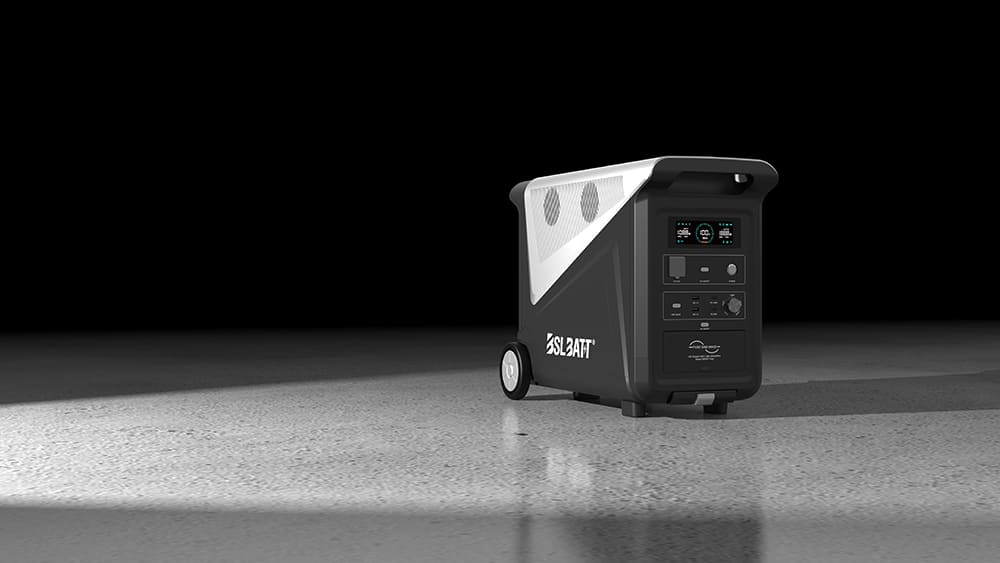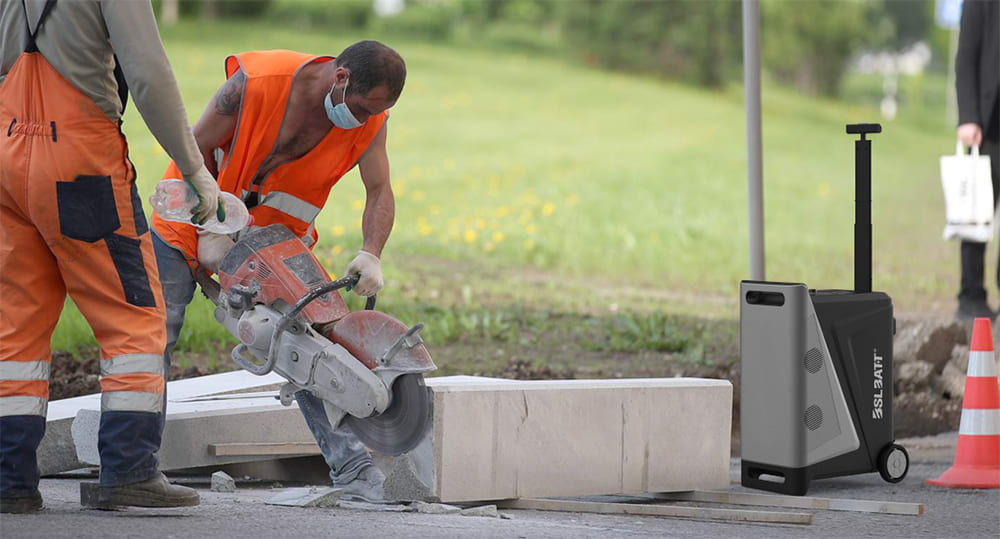Stable and reliable energy and power needs become critical as the growing population and industrialization demands lead to increasing power demand and thus the state of the grid becomes more and more complex. This article takes a look at the world of the LiFePO4 Power Station for those seeking a reliable off-grid power solution, providing insight into the safety, reliability, and convenience of LiFePO4 Power Station products.
What is a LiFePO4 Power Station?
A LiFePO4 power station is a portable energy storage system that uses lithium iron phosphate batteries to deliver clean and reliable power. You can rely on it for diverse applications, from home backup to outdoor adventures. Its popularity has surged due to unmatched safety, long lifespan, and eco-friendly design. Unlike traditional batteries, LiFePO4 technology offers high stability, lasting up to 3,000–6,000 charge cycles. These stations also align with the growing demand for sustainable energy solutions, making them a preferred choice for modern energy needs.
Key Takeaways
- LiFePO4 power stations store energy safely and are eco-friendly. They work well for home use or outdoor trips.
- These stations use strong lithium iron phosphate batteries. These batteries last over 3,000-6,000 charges, saving money on replacements.
- You can charge them with solar panels or wall plugs. This makes them useful for many energy needs.
- A battery management system keeps them safe. It checks voltage and temperature to stop overheating or overcharging.
- Buying a LiFePO4 power station saves money over time. It also helps the environment, making it a smart energy choice.
Key Features of LiFePO4 Power Stations?
LiFePO4 batteries are the backbone of a LiFePO4 power station, offering several unique advantages. These batteries are known for their exceptional safety due to their stable chemical composition. Unlike traditional lithium-ion batteries, they resist overheating and are less likely to catch fire or explode, even under extreme conditions. Their ability to withstand high temperatures without degrading ensures reliable performance in challenging environments.
Another standout feature is their longevity. LiFePO4 batteries can endure over 3,000 to 6,000 charge cycles, significantly outlasting lead-acid batteries, which typically last only a few hundred cycles. This durability makes them ideal for applications requiring frequent use. Additionally, they are environmentally friendly, as they do not contain toxic heavy metals and are recyclable, aligning with the growing demand for sustainable energy solutions.
Design and components of a LiFePO4 power station
A LiFePO4 power station integrates advanced technology and components into a compact, portable design. It typically includes a high-capacity LiFePO4 battery pack, a pure sine wave inverter for converting stored energy into usable power, and a battery management system (BMS) to monitor and protect the battery. Many models, like the BSLBATT Energipak 3840, feature multiple outlets to power various devices simultaneously. These stations also support versatile charging options, such as solar panels, wall outlets, or car chargers, ensuring adaptability for different scenarios.
Why LiFePO4 Batteries Stand Out?
Comparison with lead-acid and traditional lithium-ion batteries
LiFePO4 batteries outperform lead-acid and traditional lithium-ion batteries in several key areas. They are up to 70% lighter than lead-acid batteries, making them easier to transport. While lead-acid batteries degrade quickly with repeated use, LiFePO4 batteries maintain their capacity over thousands of cycles. Compared to traditional lithium-ion batteries, LiFePO4 batteries have a lower energy density but offer superior safety and longevity, making them a better choice for applications requiring durability and reliability.
Advantages like safety, lifespan, and performance
The safety of LiFePO4 batteries is unmatched. Their phosphate-based cathode material prevents thermal runaway, reducing the risk of fire or explosion. This makes them a dependable option for both residential and outdoor use. Their extended lifespan translates to long-term cost savings, as you won’t need frequent replacements. Additionally, their ability to perform efficiently in high-temperature environments ensures consistent power delivery, even in harsh conditions. Minimal maintenance requirements further enhance their appeal, especially for remote or off-grid installations.
With these features, a LiFePO4 power station provides a reliable, eco-friendly, and cost-effective energy solution for modern needs.
How Does a LiFePO4 Power Station Work?
Battery pack: The energy storage unit
The battery pack serves as the heart of a LiFePO4 power station. It stores energy in the form of direct current (DC) and ensures a steady supply of power for your devices. LiFePO4 batteries, known for their stability and longevity, make these power stations highly reliable. With a nominal voltage of 3.2V per cell, these batteries deliver consistent performance while resisting degradation over time. Their ability to handle thousands of charge cycles ensures you get long-term value and dependable energy storage.
Inverter: Converting stored energy into usable power
The inverter plays a crucial role in making the stored energy usable. It converts the DC power from the battery pack into alternating current (AC), which is compatible with most household and electronic devices. High-quality inverters, like those found in the Energipak 3840, achieve efficiency rates of 80-85%, minimizing energy loss during the conversion process. This ensures that your devices receive stable and efficient power, whether you’re at home or outdoors.
Battery management system (BMS): Ensuring safety and efficiency
The BMS is the brain of the power station, ensuring the safety and efficiency of the battery pack. It monitors and manages critical parameters such as voltage, temperature, and charge levels. By protecting against overcharging, over-discharging, and overheating, the BMS minimizes risks and extends the battery’s lifespan. It also balances cell voltages to maintain uniform performance and communicates with external devices for real-time monitoring. These features make the BMS indispensable for safe and reliable operation.
Charging and Discharging Process
The charging process in a LiFePO4 power station follows the CCCV (constant current, constant voltage) method. Initially, the battery charges at a constant current of 0.3C until it reaches a voltage of 3.65V per cell. At this point, the voltage remains constant while the current gradually decreases. During discharge, the battery releases energy at a safe rate of 1C to 3C, ensuring optimal performance. To prevent damage, you should avoid discharging below 2.5V per cell.
Charging options: solar panels, wall outlets, and more
LiFePO4 power stations offer versatile charging options to suit different needs. You can recharge them using solar panels, wall outlets, or car chargers. Solar panels provide an eco-friendly solution, especially for outdoor use, while wall outlets offer a quick and convenient method at home. The Energipak 3840, for instance, supports multiple charging circuits and allows you to adjust the input power from 300W to 1500W. This flexibility ensures you can recharge efficiently, regardless of your location or energy source.
Benefits of LiFePO4 Power Stations: Safety and Reliability
Non-flammable and stable chemical structure
LiFePO4 batteries offer unmatched safety due to their stable chemical composition. Unlike other lithium-ion chemistries, they resist thermal runaway, a phenomenon that can lead to fires or explosions. Their phosphate-based cathode material remains chemically stable even when damaged, ensuring safe operation in various conditions. These batteries also exhibit thermal stability, allowing them to withstand high temperatures without degrading. This makes a LiFePO4 power station a dependable choice for both residential and outdoor use.
Key Safety Features:
- Lower risk of thermal runaway compared to other lithium-ion batteries.
- Resistance to chemical reactions under physical damage.
- Resistance to overheating and overcharging
LiFePO4 batteries excel in handling extreme conditions. They operate safely across a wide temperature range, reducing risks from external factors like heat. Advanced battery management systems (BMS) further enhance safety by monitoring voltage, temperature, and charge levels. These systems prevent overcharging and overheating, ensuring the battery remains in optimal condition. This reliability is crucial for applications like healthcare, where uninterrupted power is essential.
Additional Benefits:
- Built-in safety mechanisms in the BMS.
- Stability under high-temperature environments.
Longevity and Cost-Effectiveness
LiFePO4 batteries significantly outlast other battery technologies. While lead-acid batteries typically last 300 cycles and traditional lithium-ion batteries last up to 1,500 cycles, LiFePO4 batteries deliver over 3,000 to 6,000 cycles. This extended lifespan translates to at least a decade of reliable service. For example, the Energipak 3840 utilizes advanced EVE lithium batteries, ensuring long-term performance for demanding applications.
| Battery Type | Lead-Acid | Lithium-Ion | LiFePO4 |
| Average Lifespan (Years) | 3-5 | 5-10 | 10+ |
| Cycle Life (Cycles) | 300 | 500-1500 | 3000-6000 |
| Temperature | 20℃ to 30℃ | 0℃ to 45℃ | -20°C to 55℃ |
Lower maintenance and replacement costs
The durability of LiFePO4 batteries reduces the need for frequent replacements, lowering long-term costs. Unlike gas generators, which require fuel and regular maintenance, LiFePO4 power stations operate with minimal upkeep. Their high energy efficiency, with round-trip efficiency up to 98%, further reduces electricity bills. Although the initial investment may be higher, the long-term savings make them a cost-effective solution.
Cost Advantages:
- No fuel or oil changes required.
- Reduced energy losses during charging and discharging.
Environmental Impact: Reduced carbon footprint
LiFePO4 power stations contribute to a cleaner environment. Unlike other lithium-ion batteries, they do not contain harmful heavy metals like cobalt. This reduces the risk of chemical leaks and minimizes environmental harm during production and disposal. Additionally, their compatibility with renewable energy sources, such as solar panels, further lowers their carbon footprint.
Eco-Friendly Features:
- Absence of toxic heavy metals.
- Sustainable integration with renewable energy systems.
Recyclability of LiFePO4 batteries
Recycling processes for LiFePO4 batteries are highly effective. Techniques like hydrometallurgy extract valuable materials, such as lithium, for reuse. This process operates at ambient temperature and pressure, achieving high efficiency while minimizing environmental impact. The recycling steps include disassembling, crushing, and purifying the battery components, ensuring minimal waste. These efforts make LiFePO4 batteries a sustainable choice for energy storage.
Recycling Process Highlights:
- High metal recovery rates through hydrometallurgy.
- Reduced environmental impact during recycling.
Choosing a LiFePO4 power station not only ensures safety and reliability but also supports a sustainable future.
Practical Applications of LiFePO4 Power Stations
Home backup during power outages
A LiFePO4 power station provides a dependable solution for keeping your home powered during unexpected outages. Its ability to store energy ensures that essential devices like refrigerators, lights, and communication tools remain operational. With multiple AC outlets and USB ports, you can connect a variety of devices simultaneously. This versatility allows you to maintain normalcy during disruptions, whether you’re working from home or ensuring your family’s comfort.
Tip: Use a LiFePO4 power station with solar panels for a sustainable backup system that reduces reliance on the grid.
Outdoor activities like camping and road trips
When you’re exploring the great outdoors, a LiFePO4 power station becomes an invaluable companion. It offers clean, quiet energy, allowing you to power devices like cameras, portable stoves, and even small refrigerators. You can recharge it using solar panels, making it ideal for off-grid adventures. Its silent operation ensures you enjoy nature without the noise of traditional generators.
1. No emissions, making it environmentally friendly.
2. Quiet operation, preserving the tranquility of your surroundings.
3. Solar compatibility, enabling renewable energy use on the go.
C&I Applications: Backup power for businesses
Businesses rely on uninterrupted power to maintain operations. A LiFePO4 power station ensures critical systems like servers, security cameras, and communication networks stay functional during outages. Its clean and silent operation makes it suitable for sensitive environments like hospitals and offices. Additionally, integrating it with solar panels enhances sustainability and reduces long-term energy costs.
1. Reliable emergency backup for essential devices.
2. Long-term cost savings through reduced maintenance and operational expenses.
3. Increased energy efficiency compared to traditional batteries.
Integration with renewable energy systems
LiFePO4 power stations play a vital role in renewable energy setups. They store excess energy generated by solar or wind systems, ensuring a steady supply even when production fluctuates. Their long cycle life and safety features make them ideal for grid peak shaving and distributed power stations. These applications enhance grid stability and reduce the risk of outages in critical facilities.
1. Manage fluctuations in renewable energy sources.
2. Serve as an alternative to traditional energy storage systems.
3. Provide reliable power for distributed energy networks.
Emergency and Off-Grid Scenarios: Disaster preparedness and relief efforts
In disaster scenarios, a LiFePO4 power station offers reliable and long-lasting power. It can support critical systems like medical equipment, communication devices, and lighting in emergency shelters. Its fire-resistant and corrosion-resistant properties ensure safe operation under challenging conditions. With over 3,000 charge cycles, it provides consistent power for extended recovery periods.
1. Powers essential systems during disaster recovery.
2. Ensures safety with fire-resistant and stable chemical properties.
3. Portable solutions for remote areas affected by disasters.
Off-grid living and remote work setups
For off-grid living or remote work, a LiFePO4 power station delivers unmatched convenience. Its portability allows you to carry it easily, while its quiet operation ensures a peaceful environment. Multiple charging options, including solar input, make it adaptable to various needs. You can power laptops, lights, and other devices without worrying about noise or harmful emissions.
1. Portable and user-friendly design.
2. Versatile charging options for different devices.
3. Cost-effective with low maintenance and a long lifespan.
Note: A LiFePO4 power station like the Energipak 3840 combines portability, reliability, and sustainability, making it an excellent choice for diverse applications.
Maintenance and Cost Considerations
Maintenance Tips for LiFePO4 Power Stations
To ensure your LiFePO4 power station operates at peak performance, follow proper charging and discharging practices. Use chargers specifically designed for LiFePO4 batteries to avoid overcharging or undercharging. Monitor the Battery Management System (BMS) regularly to check voltage, temperature, and charge levels. This helps prevent issues like overheating or over-discharging, which can shorten the battery’s lifespan. Clean the battery terminals periodically to remove dust and debris, ensuring optimal electrical connections. Additionally, balance the cells to maintain equal charge levels across the battery pack, which enhances overall efficiency.
Tip: Keep the operating temperature between 15°C and 30°C (59°F to 86°F) for the best results.
Storage guidelines to maximize battery life
Proper storage is crucial for extending the life of your LiFePO4 power station. Store the battery at a charge level between 50% and 80% to minimize stress on the cells. Avoid storing it fully charged or completely discharged, as this can degrade the battery over time. Choose a cool, dry location away from direct sunlight and extreme temperatures. For long-term storage, disconnect the battery from devices to prevent accidental discharge. Check the battery voltage periodically and recharge it if the voltage drops below the recommended level.
Note: Charge the battery to around 50-70% capacity before storing it for extended periods.
Cost-Effectiveness
Initial investment vs. long-term savings
While a LiFePO4 power station may require a higher initial investment compared to traditional options, its long-term savings make it a worthwhile choice. These power stations feature extended lifespans, often exceeding 3,000 to 6,000 charge cycles, which reduces the need for frequent replacements. Their low maintenance requirements and superior energy efficiency further contribute to cost savings. Over time, the reduced operational costs outweigh the upfront expense, making them a cost-effective solution for energy storage.
Comparison with traditional gas generators
LiFePO4 power stations offer significant advantages over traditional gas generators. They eliminate the need for fuel, oil changes, and regular mechanical maintenance, which lowers ongoing costs. Unlike gas generators, they operate silently and produce no emissions, making them environmentally friendly. Additionally, their high energy efficiency ensures minimal energy loss during charging and discharging. Although gas generators may have a lower upfront cost, the long-term expenses associated with fuel and maintenance make LiFePO4 power stations a more economical option.
Key Takeaway: Investing in a LiFePO4 power station provides both financial and environmental benefits, ensuring reliable energy for years to come.
A LiFePO4 power station offers a modern solution for clean, reliable, and versatile energy storage. Its advanced functionality, including safety features, extended lifespan, and minimal maintenance, makes it ideal for diverse applications like home backup, outdoor adventures, and industrial use. Compared to traditional gas generators, it provides unmatched safety, silent operation, and eco-friendly performance, ensuring peace of mind in any setting.
If you’re seeking a dependable energy solution, consider the Energipak 3840 by BSLBATT. With its high capacity, multiple output options, and advanced safety features, it delivers exceptional performance for both everyday and critical needs. Whether you’re preparing for emergencies or embracing off-grid living, this power station ensures you stay powered wherever life takes you.
FAQ:
What devices can a LiFePO4 power station power?
A LiFePO4 power station can power a wide range of devices, including laptops, smartphones, refrigerators, medical equipment, and small appliances. Its multiple outlets and high capacity make it suitable for both everyday use and emergency scenarios.
How long does it take to charge a LiFePO4 power station?
Charging time depends on the input source. Wall outlets typically take 6-8 hours, while solar panels may take longer depending on sunlight conditions. Models like the Energipak 3840 allow adjustable input power for faster charging. It can be charged in as little as 3 hours.
Can you use a LiFePO4 power station while charging it?
Yes, most LiFePO4 power stations support pass-through charging. This feature lets you charge the station while simultaneously powering connected devices, ensuring uninterrupted energy supply.
How do you maintain a LiFePO4 power station?
Store it in a cool, dry place at 50-80% charge. Avoid overcharging or deep discharging. Regularly clean terminals and monitor the Battery Management System (BMS) for optimal performance.
Are LiFePO4 power stations safe for indoor use?
Yes, they are safe for indoor use. Unlike gas generators, they produce no emissions and operate silently. Their stable chemical structure and advanced safety features minimize risks like overheating or fire.
Post time: Feb-12-2025












